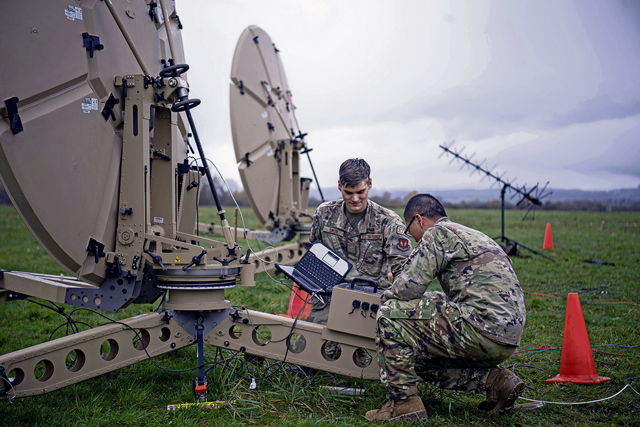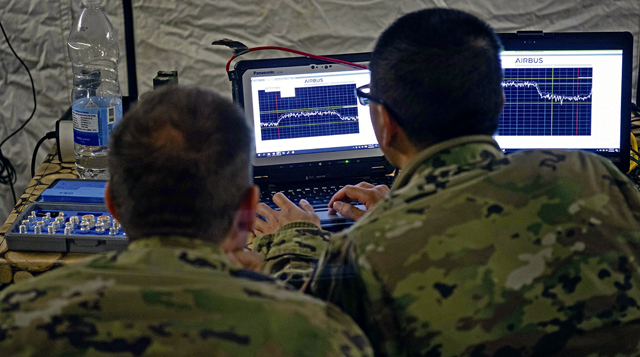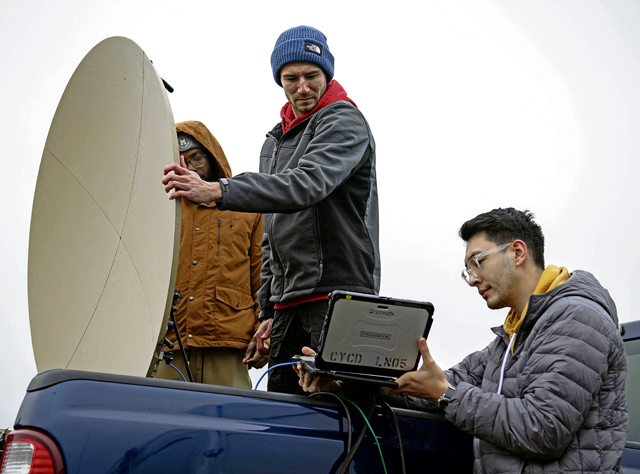
U.S. Air and Space Forces Airmen and Guardians assigned to the 435th Air Ground Operations Wing, 693rd Intelligence Support Squadron, and the 450th Intelligence Squadron at Ramstein Air Base, as well as joint forces and several NATO units, participated in exercise HEAVY RAIN 23 primarily in Grostenquin, France, and four other locations in Germany, Nov. 14-17.
The purpose of the exercise was to refine warfighting communications through various scenarios similar to what joint forces may encounter in the European theater, and promote the ability to adapt in an ever-changing operational environment.
“In order to decisively employ airpower at the forward edge of battle, we must train to deploy adaptive expeditionary communications in the contested, degraded spectrum environment we expect to encounter in Europe,” said U.S. Air Force Lt. Col. Mitch Brown, 1st Combat Communications Squadron commander. “In a near-peer fight, the operating environment is changing rapidly, requiring commanders to employ forces dynamically.”

Being the fourth iteration of this exercise, HEAVY RAIN 23 saw unprecedented feats achieved by Airmen, and the integration of non-kinetic effects in exercise scenarios that made this year’s event especially noteworthy.
Most notably, HEAVY RAIN 23 was organized and executed by Airmen assigned to the 1st Combat Communications Squadron, a feat typically achieved at the wing level or above.
“HEAVY RAIN 23 looked and felt like a command-level exercise, but it was entirely planned, hosted, and executed at the squadron level,” Brown said. “I cannot say enough about the 360 men and women of 1st Combat Comm. These Airmen are focused on getting after our biggest problem sets, and their dedication and talent for innovation is awe inspiring.”
Additionally, unlike previous exercise iterations, HEAVY RAIN 23 incorporated non-kinetic effects such as network degradation, Ultra High Frequency/Very High Frequency (UHF/VHF) degradation, and command and control of ground forces via high frequency radio during the exercise scenarios.

“C2 is a key operations focus for USAFE-AFAFRICA and all component military organizations, as well as our international partners, as we train to engage potential adversaries in an increasingly complex battle space that requires greater agility and effective adaptability,” Brown said. “During HEAVY RAIN 23, our teams not only exercised their ability to project command and control communications to the forward edge, but also exercised our ability to C2 our own forces in the field. By doing so, we are building processes for ensuring the C2 provider is at the right location at a tempo that is relevant to the fight.”
Throughout the exercise, participants were required to identify electromagnetic interference, report EMI with a Joint Spectrum Interference Report, and mitigate interference during the scenarios within an hour to maintain C2.
Participants successfully completed these tasks beyond their standard training environment by applying their skills in establishing and troubleshooting communications; understanding and perfecting EMI mitigation processes in a degraded environment; locating and identifying hostile intent; and showcasing the ability to establish initial operating capabilities.
Brown added that exercises such as HEAVY RAIN provide a unique opportunity for U.S. Armed Forces, allies and partners to implement these learned skills and refine their C2 and Intelligence, Surveillance and Reconnaissance capabilities in a joint operational environment.
“We believe HEAVY RAIN and exercises of the like are absolutely critical to our national security strategy,” Brown said. “When we force ourselves beyond the table-top, our learning will accelerate. We will gain a deeper understanding of how to evolve our training and inform our resourcing in the out years, ensuring our experts are ready to fight in the spectrum.”
HEAVY RAIN is one of many exercises held periodically to maintain communication and data-sharing capabilities among U.S. military branches, allies and partners, Brown added. Working together assists in identifying and overcoming institutional barriers that would inhibit effective integration of joint forces, partners and allies in an operational environment — ultimately ensuring global security.


